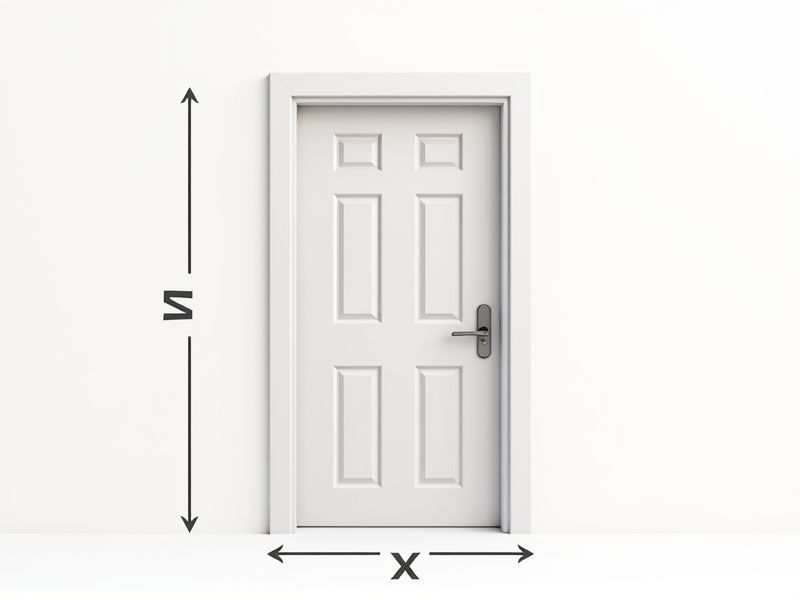
When selecting an exterior door, it's helpful to know that the most common standard dimensions are 36 inches wide by 80 inches tall. Many exterior doors are also available in widths of 32 or 34 inches, depending on the needs of your entryway or renovation project. The standard door thickness is typically 1 3/4 inches, providing durability and security suitable for outdoor use. Always remember to measure your existing doorway and check local building codes before purchasing to ensure a proper fit and smooth installation.
Width Measurements
The standard width for exterior doors typically ranges from 30 inches to 36 inches, accommodating various entryway sizes. A 32-inch door is the most common choice for residential properties, providing a balance between accessibility and aesthetic appeal. When considering accessibility, doors that are 36 inches wide are often recommended to facilitate wheelchair entry and movement. Be sure to measure the door frame accurately, allowing for adjustments due to settling or structural changes over time.
Height Measurements
The standard height for an exterior door typically measures 80 inches, catering to most residential and commercial buildings. Custom options may range from 84 to 96 inches, accommodating unique architectural designs or accessibility requirements. When considering door replacement, it's essential to measure from the floor to the top of the frame to ensure a proper fit. For enhanced security and energy efficiency, exterior doors should also comply with local building codes, which often dictate minimum height specifications.
Thickness Standards
The standard thickness for exterior doors typically ranges from 1.75 inches to 2 inches, with most residential doors measuring 1.75 inches thick. This thickness ensures enhanced security and better insulation, contributing to energy efficiency. For commercial applications, doors may measure between 1.875 inches and 2.25 inches thick, designed to withstand higher traffic and wear. When selecting an exterior door, you should consider the material and thickness to optimize durability and performance.
Door Material Options
Exterior doors can be constructed from a variety of materials, each offering distinct advantages. Solid wood doors, known for their durability and aesthetic appeal, can range in price from $200 to $2,000. Steel doors provide enhanced security and energy efficiency; they typically cost between $150 and $600. Fiberglass doors are resistant to weather damage and require minimal maintenance, with prices ranging from $300 to $1,500, making them an excellent choice for long-term value.
Swing Orientation
The standard for exterior doors emphasizes swing orientation, which is classified into inswing and outswing categories. An inswing door opens inward toward the home, providing easy access and enhanced security when closed, while an outswing door opens outward, often maximizing interior space. The choice of swing orientation can impact weather resistance, energy efficiency, and room layout, influencing the overall functionality of your entryway. Proper installation must account for factors such as elevation, surrounding structures, and local building codes to ensure optimal performance and safety.
Pre-Hung Door Options
Pre-hung doors simplify installation by including the frame, hinge cuts, and weather-stripping, ensuring a complete unit ready for immediate use. Typically, a standard pre-hung door measures 80 inches in height and 36 inches in width, accommodating diverse architectural styles while enhancing accessibility. Many options feature a variety of materials, such as fiberglass or solid wood, providing durability, energy efficiency, and aesthetic appeal. Selecting the right pre-hung door can significantly impact your home's curb appeal and energy use, making it essential to consider your specific needs and climate conditions.
Custom Door Sizing
Custom door sizing offers a tailored solution for homeowners seeking the perfect fit for their exterior spaces. With dimensions ranging from standard 32 inches in width and 80 inches in height, custom doors can be crafted to accommodate unique measurements for optimal aesthetics and functionality. You can choose materials such as fiberglass, steel, or wood, allowing for various styles that enhance your home's curb appeal. Investing in custom sizing not only improves energy efficiency but also ensures added security and durability against environmental elements.
Energy Efficiency Ratings
When selecting an exterior door, focus on energy efficiency ratings, such as the U-factor and R-value, which indicate the door's insulation performance. A door with a U-factor of 0.20 or lower demonstrates excellent thermal resistance, significantly reducing energy costs. Opt for doors with ENERGY STAR certification to ensure compliance with energy efficiency guidelines, often leading to savings of 7-15% on heating and cooling expenses. You can also consider materials like fiberglass or steel, which typically provide better energy efficiency compared to traditional wood doors.
Industry Standard Compliance
The standard for exterior doors focuses on compliance with industry regulations such as those set by the American National Standards Institute (ANSI) and the Underwriters Laboratories (UL). Your exterior door must meet specific performance metrics, including a minimum insulation value of R-5 and a resistance to weather conditions categorized under ANSI/ASTM E330. These doors are typically constructed from durable materials like fiberglass, wood, or steel, ensuring a lifespan of 20 to 30 years with proper maintenance. Additionally, factors such as security ratings, fire resistance, and energy efficiency contribute to the overall safety and functionality of your door, making adherence to these standards essential for both residential and commercial properties.
Installation Guidelines
When installing an exterior door, ensure that the door frame is level and plumb, as this guarantees optimal functionality and energy efficiency. Use a measuring tape to confirm that the distance between the top and bottom of the frame remains consistent, ideally around 80 inches for a standard height. The gap around the door should be about 1/8 inch on the sides and top, and a slightly larger gap at the bottom to accommodate door sweeps and weather stripping. Secure the door using at least three hinges, spaced evenly, with screws that are no shorter than 3 inches to ensure stability and durability.
